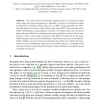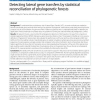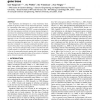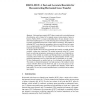RECOMB
2012
Springer
12 years 4 months ago
2012
Springer
Abstract. Lateral gene transfer (LGT) is a common mechanism of nonvertical evolution where genetic material is transferred between two more or less distantly related organisms. It ...
112
click to vote
RECOMB
2011
Springer
13 years 4 months ago
2011
Springer
One of the criteria for inferring a species tree from a collection of gene trees, when gene tree incongruence is assumed to be due to incomplete lineage sorting (ILS), is minimize ...
IANDC
2011
13 years 8 months ago
2011
Abstract. Gene trees are leaf-labeled trees inferred from molecular sequences. Due to duplication events arising in genome evolution, gene trees usually have multiple copies of som...
SIAMCOMP
2000
14 years 1 months ago
2000
This paper studies various algorithmic issues in reconstructing a species tree from gene trees under the duplication and the mutation cost model. This is a fundamental problem in c...
JCB
2007
14 years 1 months ago
2007
Prokaryotic organisms share genetic material across species boundaries by means of a process known as horizontal gene transfer (HGT). This process has great significance for unde...
BMCBI
2006
14 years 1 months ago
2006
Background: In the genomic age, gene trees may contain large amounts of data making them hard to read and understand. Therefore, an automated simplification is important. Results:...
BMCBI
2010
14 years 1 months ago
2010
Background: Phylogenetic relationships between genes are not only of theoretical interest: they enable us to learn about human genes through the experimental work on their relativ...
BMCBI
2010
14 years 1 months ago
2010
Background: To understand the evolutionary role of Lateral Gene Transfer (LGT), accurate methods are needed to identify transferred genes and infer their timing of acquisition. Ph...
ISMB
2007
14 years 4 months ago
2007
Gene duplication and divergence is a major evolutionary force. Despite the growing number of fully sequenced genomes, methods for investigating these events on a genome-wide scale...
COCOON
2005
Springer
14 years 7 months ago
2005
Springer
Horizontal gene transfer (HGT) plays a major role in microbial genome diversification, and is claimed to be rampant among various groups of genes in bacteria. Further, HGT is a ma...





